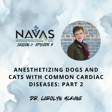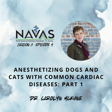
Pharmacogenetics: Gene-ius Solutions for Safer Anesthesia in Pets with Dr. Tania Perez Jimenez
We here at NAVAS are excited to bring you a new podcast episode for the new year! And we're starting out our season of the NAVAS podcast with engaging exploration of pharmacogenetics, a groundbreaking field that examines how the genetic makeup of an animal can influence its response to medications.
Have you ever had a dog or a cat that took hours, if not days, to finally return to normal after general anesthesia? It's possible that animal had a genetic mutation that altered its metabolic function, causing profound changes in the clinical effects of anesthetic drugs.
In this episode, we are joined by veterinary anesthesiologist and overall gene-ius Dr. Tania Perez Jimenez, Assistant Professor of Anesthesia at Washington State University College of Veterinary Medication and head its Pharmacogenetics Laboratory. Dr. Perez Jimenez shares her expertise on the genetic factors that impact anesthesia and pain management in dogs and cats. Together with host, Dr. Bonnie Gatson, they will discuss how genetic variations can affect drug efficacy and safety in individual animals, how you can approach anesthetic management in dog breeds that commonly manifest genetic anomalies such as MDR1 mutations, why we may need to alter the way we utilize Propofol and Alfaxalone in cats and certain dog breeds, and how we could all benefit from going to more cat shows.
Explore more information discussed on this podcast at the WSU Pharmacogenetics Laboratory website.
If you like what you hear, we have a couple of favors to ask of you:
Become a member of NAVAS for access to more anesthesia and analgesia educational and RACE-approved CE content.
Spread the word. Share our podcast on your socials or a discussion forum. That would really help us achieve our mission: Reduce mortality and morbidity in veterinary patients undergoing sedation, anesthesia, and analgesia through high-quality, peer-reviewed education.
Thank you to our sponsor, Dechra - learn more about the pharmaceutical products Dechra has to offer veterinary professionals, such as Zenalpha.
If you have questions about this episode or want to suggest topics for future episodes, reach out to the producers at education@mynavas.org.
All opinions stated by the host and their guests are theirs alone and do not represent the thoughts or opinions of any corporation, university, or other business or governmental entity.










